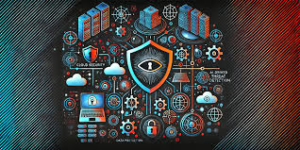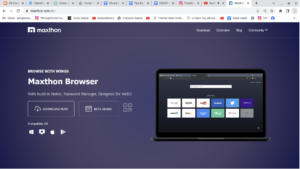The realm of cybersecurity is in a perpetual state of flux. Every day brings fresh challenges and cutting-edge technologies, making it essential for organisations like CMS to remain vigilant and well-informed about the latest trends.
In this discussion, we will delve into the top five emerging trends shaping the future of cybersecurity. These developments are redefining how entities combat cyber threats, offering both new opportunities and obstacles to navigate.

Understanding these trends isn’t just beneficial; it’s imperative for safeguarding our systems and sensitive data. By keeping abreast of these advancements, we can proactively fortify our defences against potential attacks.
As we explore each trend, you’ll discover how they impact our strategies at CMS and the broader digital security landscape. This knowledge equips us not only to react but also to anticipate and prepare for evolving threats.
Why is this important? The landscape of cybersecurity is constantly evolving, marked by significant advancements and persistent challenges. These trends not only reflect the current state of security but also provide crucial insights that can help us enhance our protective measures.
Staying informed about these developments is vital for everyone at CMS, whether you’re just starting your career or have years of experience. Awareness fosters a culture of vigilance, ensuring that we all play a role in effectively securing our information and systems.
As new technologies emerge, so do innovative attack methods. Understanding these shifts empowers us to anticipate potential threats and adapt accordingly. This proactive approach is essential in a time when data breaches and cyberattacks happen with alarming frequency.

Moreover, embracing continuous learning about cybersecurity trends helps integrate robust security practices into our daily operations. Safeguarding our organisation is not just the responsibility of IT or security teams; every individual has a part to play.
Being well-versed in these matters not only protects CMS but also builds trust with clients and stakeholders. In essence, knowledge is power—and in the realm of cybersecurity, it’s also protection.
In today’s digital age, the importance of cybersecurity cannot be overstated. The landscape is in constant flux, characterised by rapid advancements alongside persistent challenges. These trends serve as not only benchmarks of our current security status but also valuable insights that can inform and enhance our protective strategies.

For everyone at CMS—whether you’re a newcomer or a seasoned professional—being attuned to these developments is essential. An informed team fosters a culture of vigilance, empowering every member to contribute actively to safeguarding our information and systems.
As technology evolves, so too do the methods employed by malicious actors. By understanding these shifts, we can better anticipate potential threats and refine our defences accordingly. This proactive stance is crucial given the alarming frequency of data breaches and cyberattacks today.
Moreover, committing to continuous learning about emerging cybersecurity trends helps us integrate robust security practices into our daily operations. It reinforces the idea that protecting our organisation is not solely an IT responsibility; it is a collective effort that requires participation from all team members. In this way, we can build a resilient fortress around our critical data and infrastructure.
In today’s digital age, the importance of cybersecurity cannot be overstated. The landscape is in constant flux, characterised by rapid advancements alongside persistent challenges. These trends serve as not only benchmarks of our current security status but also valuable insights that can inform and enhance our protective strategies.
For everyone at CMS—whether you’re a newcomer or a seasoned professional—being attuned to these developments is essential. An informed team fosters a culture of vigilance, empowering every member to contribute actively to safeguarding our information and systems.
As technology evolves, so too do the methods employed by malicious actors. By understanding these shifts, we can better anticipate potential threats and refine our defences accordingly. This proactive stance is crucial given the alarming frequency of data breaches and cyberattacks today.

Moreover, committing to continuous learning about emerging cybersecurity trends helps us integrate robust security practices into our daily operations. It reinforces the idea that protecting our organisation is not solely an IT responsibility; it is a collective effort that requires participation from all team members. In this way, we can build a resilient fortress around our critical data and infrastructure.
Extended Detection and Response (XDR) is revolutionising the landscape of cybersecurity by offering a unified method for threat detection and response. Unlike traditional security solutions that operate in silos, XDR consolidates data from various security products—such as endpoints, networks, and servers—into one cohesive system.
This integration grants organisations a panoramic view of their security posture, enabling them to detect potential threats more effectively. By analysing data across multiple layers of an environment, XDR enhances visibility and context regarding possible vulnerabilities.
For organisations like CMS, incorporating XDR translates into significantly improved incident response capabilities. Instead of reacting in isolation to individual alerts from disparate systems, teams can respond to threats with a coordinated strategy that considers all aspects. This approach not only streamlines the investigation process but also accelerates remediation efforts, substantially reducing the time adversaries have to exploit weaknesses.
Ultimately, adopting XDR represents a strategic shift toward a more resilient defence mechanism. It fosters collaboration among security technologies and teams while empowering organisations to stay one step ahead in an ever-evolving threat landscape.
The transition to cloud services is transforming how organisations operate. However, with this shift comes an imperative need for robust cloud security measures. Protecting sensitive data in a virtual environment poses unique challenges that must be addressed comprehensively.

Identity and access management (IAM) is at the heart of adequate cloud security. This entails implementing stringent controls to ensure that only authorised personnel can access critical information. By incorporating multifactor authentication and regular audits, organisations can significantly reduce the risk of unauthorised access.
Encryption serves as another vital layer of protection. By encrypting data both at rest and in transit, businesses can safeguard their information from potential breaches. Even if malicious actors gain entry into a system, well-encrypted data remains unreadable without the proper keys.
Continuous monitoring also plays a crucial role in maintaining a secure cloud environment. By constantly analysing activity logs and user behaviours, organisations can detect anomalies swiftly, allowing them to respond proactively before threats escalate.
As agencies like CMS increasingly leverage cloud-based applications for storing and processing sensitive information, they must prioritise these security practices. It’s not just about compliance; it’s about creating a fortress around valuable assets in an ever-evolving digital landscape. Ultimately, strong cloud security measures are essential not only for protection but also for instilling trust among users and stakeIn today’s digital landscape, concerns about data privacy are more prominent than ever. Privacy-enhancing technologies (PETs) emerge as a beacon of hope, providing innovative solutions that safeguard personal information while still enabling valuable data analysis.
These technologies, including homomorphic encryption and differential privacy, represent significant advancements in how we handle sensitive information. Homomorphic encryption allows data to be processed in its encrypted form, meaning that sensitive details remain protected even during analysis. This ensures that computations can be performed without exposing the actual data.

Conversely, differential privacy provides robust methods for analysing datasets while minimising the risk of identifying individuals within those datasets. By adding controlled noise to the results, it effectively balances utility and confidentiality.
For healthcare organisations like CMS, embracing PETs is not just a technical upgrade; it’s an essential step towards compliance with stringent privacy regulations such as HIPAA. Implementing these technologies enhances our ability to protect patient data rigorously while still harnessing insights from large datasets.
Ultimately, adopting PETs not only fortifies our commitment to patient privacy but also sets a precedent for responsible data usage in healthcare—ensuring trust between patients and providers in an era where data integrity is paramount. With these innovations at our disposal, CMS can lead the charge in fostering a secure and compliant digital future. Holders alike.

What Steps Should Individuals Take Moving Forward?
As we navigate the rapidly evolving technological landscape, one area that warrants our attention is the diverse applications of blockchain technology. It’s worth delving into how this innovative approach can be harnessed to safeguard data transactions and uphold the integrity of records within your organisation. By initiating pilot projects, you can effectively evaluate the potential advantages that blockchain may offer, allowing for informed decisions regarding its implementation.
In addition to exploring blockchain, it is crucial to consider the integration of artificial intelligence (AI) and machine learning (ML) tools available in today’s market. These advanced solutions can significantly enhance your current security framework. By incorporating AI and ML into your existing systems, you can bolster your ability to detect threats promptly and improve response times when incidents occur.
Furthermore, a thorough assessment of your current security tools is essential. This evaluation should lead you to contemplate adopting an Extended Detection and Response (XDR) platform. Such a solution would provide a cohesive overview of your overall security posture, fostering improved coordination among various components of your security infrastructure and streamlining incident response efforts.

As organisations increasingly rely on cloud services, it becomes imperative to fortify cloud security measures. A comprehensive review of your cloud security policies will help ensure adherence to best practices. Key elements include maintaining proper configuration management, conducting regular audits, and implementing sophisticated security controls such as identity and access management (IAM) alongside robust encryption techniques.
Lastly, it’s essential not to overlook the significance of privacy-enhancing technologies (PETs). Take time to investigate these innovations, which can seamlessly integrate into your data processing workflows. By adopting PETs, you can strengthen privacy protections while still preserving the utility of data—striking a balance between safeguarding sensitive information and maximising its value for organisational use.

In summary, by taking these steps—exploring blockchain applications, leveraging AI and ML tools, implementing XDR solutions, strengthening cloud security measures, and integrating privacy-enhancing technologies—you will be well-equipped to navigate the complexities of modern data management while ensuring robust protection against emerging threats.
Maxthon
In today’s world, Smartphones have woven themselves into the very fabric of our everyday existence, making their protection more critical than ever. If you’re ready to embark on the mission of securing your device, the first thing you’ll want to do is locate the Maxthon Security application. Imagine yourself scrolling through your device’s app store, fingers dancing across the screen as you enter Maxthon Security in the search bar. With a simple tap on the download button, you initiate a process that will bolster your phone’s defence.
As installation wraps up, excitement builds within you. You can hardly wait to explore how this app can enhance your smartphone’s security features. Upon launching it for the first time, a prompt appears before you, urging you to create a strong password or PIN. This isn’t just any ordinary password; envision it as a fortress crafted from letters, numbers, and symbols—a combination designed to withstand potential intruders.
Once you’ve chosen and confirmed a secure password that satisfies you, it’s time to safeguard your device more thoroughly. If your smartphone is equipped with biometric technology, such as fingerprint recognition or facial scanning capabilities, now is an opportune moment to utilise these advanced features. Navigate through Maxthon Security’s settings and activate these options; they will provide an extra layer of protection against unwanted access.

With those essential steps behind you, it’s crucial to enable real-time protection—a feature engineered for vigilance against emerging threats in cyberspace. Within Maxthon Security’s settings menu lies this powerful tool; activating it means that your phone will continuously monitor for any lurking dangers in the digital realm. Should anything suspicious come up, you’ll receive immediate alerts—like having an ever-watchful guardian by your side.
However, don’t become complacent just yet! Regular updates are vital for ensuring that Maxthon Security operates at its highest level against evolving cyber threats. To make things easier on yourself, consider turning on automatic updates within your device settings so that you can effortlessly stay ahead of newly discovered vulnerabilities without lifting a finger.
Next comes another critical task: performing a comprehensive scan of your entire device using Maxthon’s scanning function. Visualise this step as deploying an investigative team tasked with meticulously searching every corner of your smartphone’s system for malware or other cyber risks. Follow any instructions provided by the app closely; addressing issues swiftly can make all the difference in maintaining robust security integrity.
As you continue along this path toward thorough protection, managing application permissions wisely is equally important. Take some time to review all apps installed on your device; adjust their permissions both via Maxthon Security and within your phone’s main settings menu. Be selective about granting access—especially when sensitive information is involved—as not every request comes with good intentions.
Finally, a solid security strategy is only complete with regular data backups! Make it part of your routine to consistently back up essential information; after all, having recovery options available during instances of data loss or breaches could be invaluable down the road. Whether utilising reliable cloud services or external drives for storage purposes, ensure these backups are encrypted for added peace of mind.

By diligently following these steps and embracing proactive measures through tools like Maxthon Security, you’ll not only change how you engage with technology but also significantly enhance your protection in today’s increasingly intricate digital landscape.
